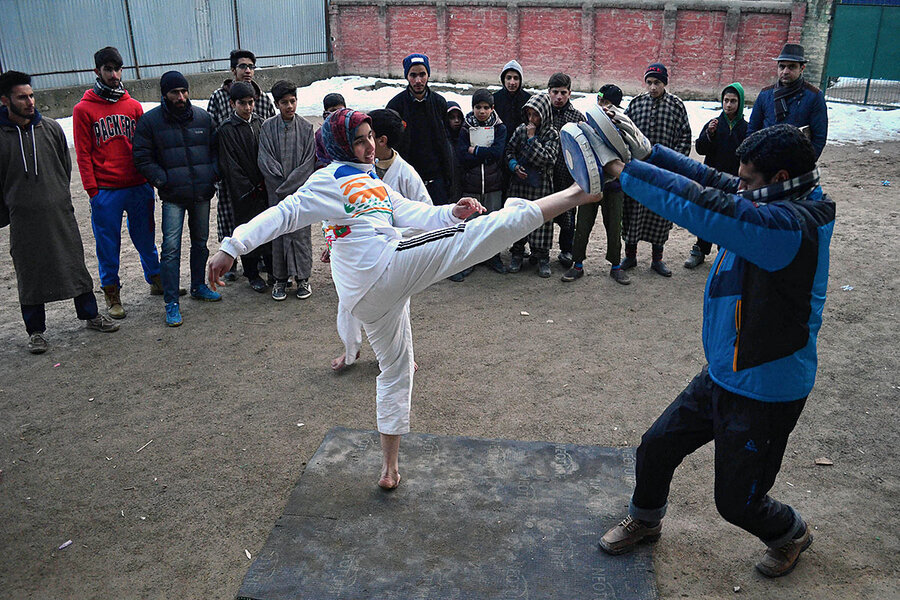Amid Kashmir's unrest, girls' sports are more than a game
Loading...
| Srinagar, India-controlled Kashmir
A few years ago, when Insha Bashir Mir began playing cricket in her neighborhood playground, she was ridiculed by neighbors who told her not to play a “boy’s game.”
But then, as now, she ignored that derision by remembering her father’s words: “Don’t answer people with your mouth, but through your bat.”
Ms. Mir, now a student at Government Women’s College in Baramulla – 40 miles north of the state capital, Srinagar – is daughter of a businessman father and homemaker mother, both of whom enthusiastically support her passion.
She’s part of new generation of local girls showing their mettle in sports, from rugby and soccer to karate. That alone is boundary-pushing. But that trend is especially meaningful here in Indian-controlled Kashmir, where opposition to Indian rule has simmered for decades and often burst into violence. Increasingly, young Kashmiris are involved, from schoolgirl stone-throwers to teenage rebel fighters. In Jammu and Kashmir state, where curfews and internet blackouts are frequent, more boys and girls alike are finding an empowering outlet through athletics.
It’s a trend officials are encouraging, with investments in previously neglected facilities and sports programs – and one that may serve as a simplified sign of peace. But the lessons on the playing field are still welcome for many teens, particularly girls, though they continue to combat stereotypes game by game. The more that people adopt Mir's and her teammates’ perspective that gender is no handicap, she says, the more optimistic she is about her generation’s future.
“We are in [the] 21st century and we shouldn’t be living like ancient times,” she says. “Girls who can carry a broom can also pick up a bat.”
Region in turmoil
Conflict-torn Kashmir is a disputed territory, claimed by both India and Pakistan; polls suggest that most residents support independence. Estimates of the death toll over the past three decades run into the tens of thousands. Today, youth are at the forefront of the movement, joining street protests and insurgency groups. Indian forces and police killed more than 200 rebels in 2017, the highest in recent years, but civilians bear a heavy cost as well: over 200 were killed in the past two years, and more than 15,000 wounded.
Right alongside, however, has been a rise in sportswomen. Last year, nearly 90,000 players from around the region participated in sports, “and almost half of them are girls,” says Waheed Ur Rehman Para, the secretary of Jammu and Kashmir State’s Sports Council.
“When I carry my cricket bat in my hand, I forget who I am, I forget my food, everything. I can do anything for cricket,” Mir says.
Since 2016, when the death of a popular rebel leader reignited unrest, the government has periodically imposed curfews and internet blackouts to quell protests. But that doesn’t stop sports, says Irtiqa Ayoub, a player and assistant coach for the state rugby team. She practiced at home, but “I still go out during curfew or protests to give training to fresher players,” says Ms. Ayoub, a student at the University of Kashmir who also runs 10 rugby clubs.
She learns from her trainees, too. To the many aspiring rugby players who message her on social media – boys and girls – her frequent reply is: “You’re most welcome. Whenever you have time, come and I will teach you.”
Budding support
Until recently, funding for sports infrastructure was hardly a priority. But since the 2016 uprising, both the Indian and regional governments have taken an interest in sports as a way to shift young people’s focus from the fiery conflict. The state is brimming with youth: Almost 70 percent of the population is younger than 35, according to the 2011 census, and about 20 percent in their teens and early 20s.
Sports can be a source of integration in a fragmented state, Mr. Para says. “We need to offer space to youth, and sports is an option. The government finds sports a meaningful means to improve leadership, sportsmanship, and team spirit among children,” he says. “There are people excelling in sports across the world. We want to figure on that global sports map, [because] it has nothing to do with guns or conflict.”
In the past, athletics facilities were simple, Mir says. Without proper facilities or a coach, she learned cricket skills by watching professional matches on television – especially with her favorite star, former Indian skipper M.S. Dhoni – or when she traveled outside the state and asked senior cricketers for tips. Now there is better infrastructure, Mir says, and officials have promised a new playing ground. But there’s still much to be done.
“We are so different from other girls in sports; it looks like we are coming from some old century,” she says. “We also need opportunities.”
Mubashir Hassan, coach and director of the State Cricket Academy, says that with the surge of interest in sports, infrastructure is getting better. He has been coaching both girls and boys at the academy, and wants the government to focus more on rural areas, in particular.
“We have raw talent but don’t have adequate facilities yet,” says Mr. Hassan. “And girls have started from scratch, so it has to be given some time before it blooms.”
'As long as I'm alive'
But there are benefits of sports for girls and society alike, Hassan says. “I think sports is conflict-neutral, like education. It is an effective part of your growth. You grow mentally.”
Many teen sports events have been organized by police. Athletics “will engage youth so that they do not get into drugs, don’t take up guns,” state police chief Shesh Paul Vaid said last September, during a rowing contest in Srinagar; “[it is] very sad to see bloodshed and sadness on the faces of the youth.”
In Para’s opinion, however, sports can’t do much for peace – but peace can boost sports, and the region’s young sportswomen, as they continue to push against stereotypes.
In Mir’s estimation, more than two-thirds of people “think girls should work inside homes and not be into sports.”
“Girls are often humiliated and harassed,” she adds. “Once while playing a cricket match many boys at the playground passed lewd comments and abuses at us, but we continued our game.”
Her efforts have paid off: Mir recently played in the region’s first-ever twenty-overs format Women’s Cricket Championship. Ayoub has also made a name for herself, winning gold and silver medals in national championships – and seen support grow. Originally, neighbors told her father not to let her go into sports, “but my father said, ‘No, I trust my daughter. She will do well,’ ” she remembers.
“Rugby is in my blood,” she says. “I won’t let anyone snatch an opportunity from me to play. I will continue as long as I’m alive.”






